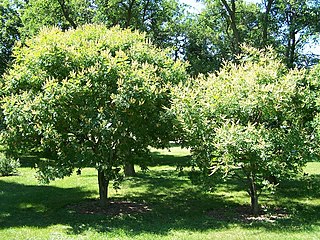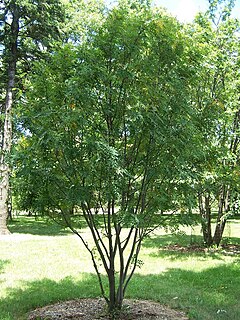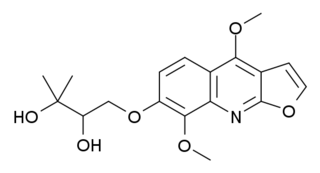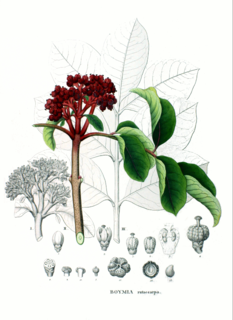
Tilia is a genus of about 30 species of trees or bushes, native throughout most of the temperate Northern Hemisphere. The tree is known as linden for the European species, and basswood for North American species. In Britain and Ireland they are commonly called lime trees, although they are not related to the tree that produces the citrus fruit lime. The genus occurs in Europe and eastern North America, but the greatest species diversity is found in Asia. Under the Cronquist classification system, this genus was placed in the family Tiliaceae, but genetic research summarised by the Angiosperm Phylogeny Group has resulted in the incorporation of this genus, and of most of the previous family, into the Malvaceae.

Tetradium is a genus of trees in the family Rutaceae, occurring in temperate to tropical east Asia. In older books, the genus was often included in the related genus Euodia, but that genus is now restricted to tropical species. In cultivation in English-speaking countries, they are known as Euodia, Evodia, or Bee bee tree.

The Salisbury University Arboretum, formerly known as the Salisbury State University Arboretum, is an arboretum on the campus of Salisbury University, 1101 Camden Avenue, Salisbury, Maryland.

Evodiamine is a chemical compound extracted from the plant genus Tetradium, which has been shown to reduce fat uptake in mouse studies. It is suspected that its mechanism of action is similar to that of capsaicin. As such, it has been included in some dietary supplements. Neither its fat-burning effects in humans nor any potential side effects have been empirically established.

Maackia is a genus of flowering plants in the legume family, Fabaceae. There are about 12 species, all native to eastern Asia, with six endemic to China. The generic name honors the botanist Richard Maack.

Correa lawrenceana, commonly known as mountain correa, is a species of shrub or small tree of the family Rutaceae and is endemic to Australia. It has elliptical to egg-shaped leaves arranged in opposite pairs and cylindrical, greenish yellow to red flowers usually arranged singly or in groups of up to seven in leaf axils with the stamens protruding beyond the end of the corolla.

Sorbus hupehensis is a species of rowan native to central and western China.

Thaumatococcus daniellii is a plant species from Africa, known for being the natural source of thaumatin, an intensely sweet protein which is of interest in the development of sweeteners. When the fleshy part of the fruit is eaten, this molecule binds to the tongue's taste buds, causing sour foods to taste sweet. It is a large, rhizomatous, flowering herb native to the rainforests of western Africa from Sierra Leone to Democratic Republic of the Congo. It is also an introduced species in Australia and Singapore.

Evoxine (haploperine) is a furoquinoline alkaloid with hypnotic and sedative effects. It is found naturally in a variety of Australian and African plants including Evodia xanthoxyloides and Teclea gerrardii.

Eriocapitella hupehensis, a species of flowering plant in the buttercup family Ranunculaceae, is native to Asia. The specific epithet hupehensis, which means "from Hupeh province, China", refers to a region where the species is known to occur. In Chinese, it is called dǎ pò wǎn huā huā, which means "broken bowl flower".

Euodia is a plant genus in the family Rutaceae. Euodia is sometimes misspelled as Evodia. The species now included in the genus Tetradium were previously included in Euodia, and may be commonly referred to as euodia.

Zanthoxylum armatum, also commonly called winged prickly ash in English, is a species of plant in the family Rutaceae. It is an aromatic, deciduous, spiny shrub growing to 3.5 meters in height, endemic from Pakistan across to Southeast Asia and up to Korea and Japan. It is a source of the spice Sichuan pepper, and also used in folk medicine, essential oil production and as an ornamental garden plant

Zanthoxylum piperitum, also known as Japanese pepper or Japanese prickly-ash is a deciduous aromatic spiny shrub or small tree of the citrus and rue family Rutaceae, native to Japan and Korea.

Rutecarpine or rutaecarpine is a COX-2 inhibitor isolated from Tetradium ruticarpum. It is claimed as one of the non-basic alkaloids.

Tetradium ruticarpum is a tree that comes from China and Korea. It was previously classified in the genus Euodia as Euodia ruticarpa. The fruit is usually used, denoted sometimes as fructus. It has a strong bitter taste, and is used in traditional Chinese medicine (TCM) and is a recognized herb in Kampo. Both the former genus name and the species name are often misspelled, and the plant usually appears in sources dealing with traditional Chinese medicine as "Evodia(e) rutaecarpa".

Tetradium glabrifolium is a species of plant in the family Rutaceae, with many synonyms but no subspecies listed in the Catalogue of Life.

Melicope rubra, commonly known as the little evodia, is a species of small tree in the family Rutaceae, and is endemic to north-east Queensland. It has trifoliate leaves and pink bisexual flowers arranged on branches below the leaves.

Melicope vitiflora, commonly known as northern evodia, fishpoison wood, leatherjacket or leatherwood, is a species of shrub or small tree in the family Rutaceae and is native to north-eastern Australia and New Guinea. It has trifoliate leaves and green to white or cream-coloured flowers borne in panicles in leaf axils.

Eriocapitella is a genus of flowering plants in the buttercup family Ranunculaceae. Plants of the genus are native to Asia. The generic name Eriocapitella roughly translates to "growing in a small woolly head", which refers to the hairy ovary and fruit of some members of the genus. Cultivated plants are commonly known as fall-blooming anemones.

Eriocapitella japonica is a species of flowering plant in the buttercup family Ranunculaceae. The specific epithet japonica means "from Japan", which is a misnomer since the species is introduced in Japan. It is native to China, Taiwan, and Vietnam.























